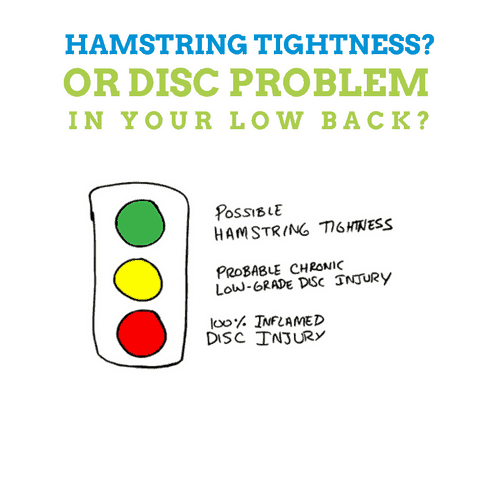
11 Apr Hamstring Tightness? Or Low Back Disc Problem?
What if you had hamstring tightness AND they were 100% healthy?
Wait, what?
You might think that doesn’t make any sense.
When it comes to how you spend your time, what if all of the stretching you’re doing for the hamstrings is serving no health or fitness purpose?
Hamstring tightness can happen for three major reasons, all which benefit from stopping the insanity of the hamstring stretching.
Most important of all is the hamstring tightness phenomenon that occurs when a disc in your low back is crying out quietly to your body.
Unfortunately, when you don’t listen to your disc, you’re at greater risk of serious disc damage.
Fortunately, when you don’t listen to your disc, your hamstrings do.
Hamstring Tightness? Or is it Protection of a Low Back Disc?
What’s so cool about the body is that it tells us where the problem is, as long as we know where to look.
If your Pencil Test (for the low back) is healthy like it is in the 5 second video below and your Hamstring Stretch Test is NOT , then you have a sciatic nerve or hamstring problem.
The most common scenario when the hamstring tightness insanity isn’t solved by stretching occurs when your pencil test is NOT healthy, but your hamstring stretch test is healthy. This is a low back problem.
I already discussed how to determine where the problem is when I told you to stop stretching your tight hamstrings, so I’m not going to go over it here.
There are some more nuanced tells for the hamstring tightness being protective for the low back.
If you don’t have a functional specialist like myself or another Integrative Diagnosis provider to check you out, here are the other signs you can look for:
- Pain or tightness in the middle of the range (known as a “pain arc” in the healthcare literature) during the Touch Your Toes Test.
- Hamstring resistance that occurs before the last 2″ of end range (in other words, you feel resistance more than 6″ away from your end range) during the Touch Your Toes Test.
- Pain or tightness at the top of the Pencil Test and/or, if you let your abs relax and belly sag.
Below, we use the metaphor of a stoplight to help you conceptualize what’s happening. Here’s a 2 minute video showing you what hamstring tightness vs. a disc problem would look like:
If you can say “YES” to one of the data points above, then you can be 95% sure that your hamstring tightness is a low back disc problem.
A Simple Way to Think About It: Yellow Light – Green Light
Your brain quite literally plays “Red Light – Green Light” with your body.
Red Light: you’d have a hard stop to your movement or it would just shut you down.
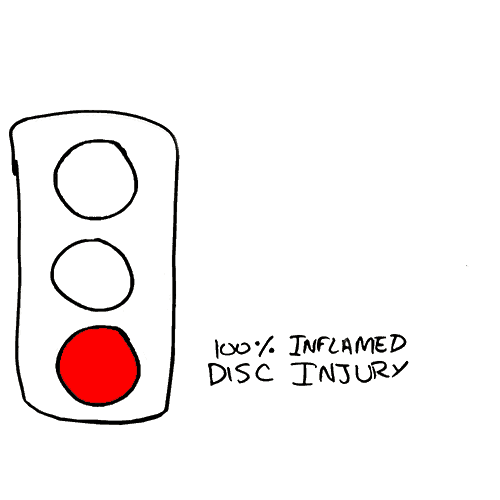
You’ve experienced Red Light if you’ve ever had a trauma to a body part and “it just gave out”.
The deadlifter who collapsed to the ground, the priest who fell on her wrist and dropped her purse, or the rugby player who sprained his ankles and hit his face on the curb after stepping on a pebble are all examples of Red Light.
If you’ve ever seriously hurt your low back like I did when I tore my hip labrum doing the Smolov Squat Program (unless you heal like Wolverine and have the genetic ability of Bo Jackson), I don’t recommend this program) and then inflaming my disc a week later, you may have hardly moved during the Touch Your Toes Test. Awesome example of Red-Lighting.
Here’s a tangent: Bo Knows.
Green Light: anything you do that feels easy or that you don’t even think about.
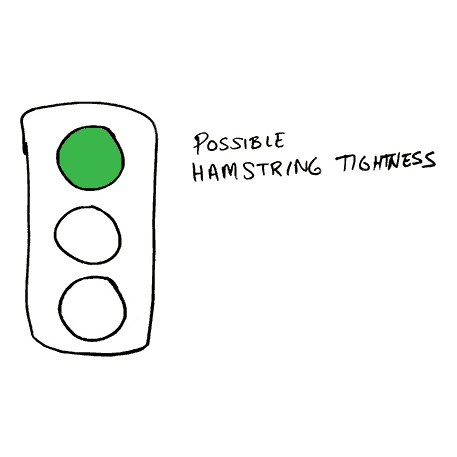
In order for your brain to Green Light your muscles, there needs to be no problem (or pathology) in your body that it wants to avoid putting stress on.
If there IS something it wants to avoid putting stress on, your brain will protect it.
That protection starts with …
Yellow Light: your body can work through a motion, but it does so slowly.
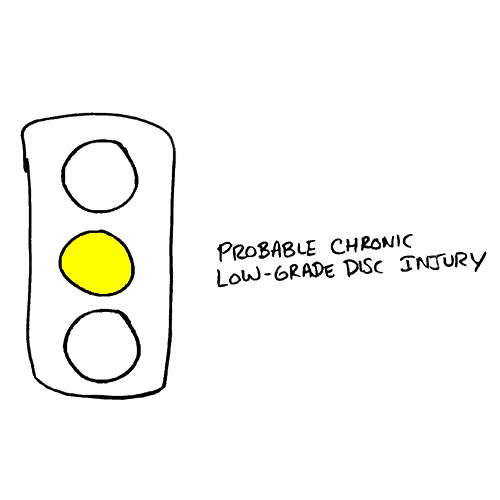
It’s your brain saying:
Oh shit, he’s going there? Ok, easy does it Buster. Hold on, slow, slowwwww … I’m still OK … a little more. Red Light, that’s all I’m giving you.
There’s a moderate sized problem that hasn’t turned into a big problem yet. Otherwise, you would have Red-Lighted way earlier.
With awareness of whether your body is:
- Green Lighting – moving easily and without resistance (no problem)
- Yellow Lighting – moving towards your normal end ranges but with resistance (moderate problem)
- Red Lighting – extremely restricted and you just can’t move (big problem) …
… You can treat your body with more respect when it comes to how you move.
The best example to what respect for your body looks like is the exerciser who does workouts 3 days a week and always has stiffness in the low back getting out of bed in the morning the day after a workout, only to take a hot shower and have that stiffness go away.
It may seem benign, but it’s dangerous. You have no awareness that you’re on the fast track to moving like an old man due to severe low back pain in single digit years. You may get away with it for a few months to few years, but your body’s subtle sign is warning you of the future.
I see many cyclists, CrossFitters, and yogis in their 30s who deal with this.
It’s not OK if you want to be functional 30 years into the future.
What To Do For Your “Hamstring Tightness”
Continue stretching your hamstring after 1 month is what Albert Einstein calls “insanity”. Doing the same thing over and over again and expecting a different result.
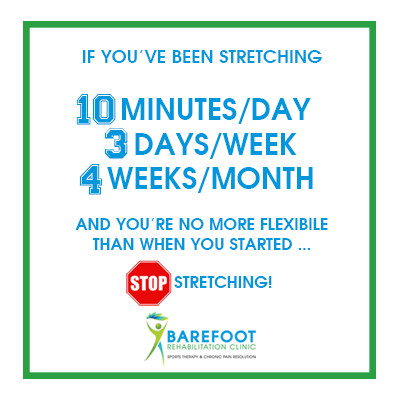
Assuming your hamstring tightness is coming from a low back disc, here the puzzle pieces of your problem:
- OVERLOAD: A history of overload on low back
- SECRET PROBLEM: the presence of a big problem that no one talks about:
- PERMANENT PROBLEM: disc damage is permanent and can’t be fixed.
- WEAKNESS: Absolute (someone who doesn’t exercise and is just weak) or relative weakness (someone who is fit but hasn’t balanced the whole body) of the low back and posterior chain
1. ADDRESS THE OVERLOAD: deload your low-back by taking a break.
It’s amazing how many people hurt their bodies but continue to do what damaged it in the first place.
There are many reasons for this:
- exercise is their stress management and not exercising = not being happy.
- if rest didn’t make the pain better and exercise doesn’t hurt it, you naturally think you can get away with more load.
- you have no trust in your doctors and don’t even entertain what a solution might look like.
Once you’ve found a path out of the pain, creating a healing environment for your body is 100% necessary.
Continued load on your body is nearly guaranteed to prevent your pain from getting fixed.
If you must exercise, stick to your:
- lunges
- planks
- side-planks
- glute-bridges
- push ups
2. ADDRESS THE SECRET PROBLEM: It’s a “secret” because:
- 95% of our new patients in Barefoot Rehab have never heard of it or have been diagnosed with it by other doctors
- it’s the most common cause of chronic pain
- it’s very easily removable by an expert.
At Barefoot Rehab, our special sauce is fixing this secret problem. It’s called adhesion. It’s the only reason we exist. Gil Hedly calls the same stuff fuzz:
When we do treatment, we fix the adhesion in several steps:
- Pencil Test or any movement that makes the pain worse (to measure “BEFORE”).
- Feel where the adhesion is the worst.
- Remove the adhesion by applying tension to it.
- Re-check the Pencil Test or the provocative movement (to measure “AFTER” and any progress).
In the 2 minute video below, I use the provocative movement of bending backwards to demonstrate to the patient how getting rid of the adhesion makes the pain better:
3. ADDRESS THE PERMANENT PROBLEM: So many patients are surprised when I say:
Your disc pain is not fixable.
Notice that I’m not saying “Your pain can’t better.”
What I am saying is that the damaged disc MUST (if you want to be mobile 30 years into the future) be respected.
Respect = awareness how your body feels with different movements, postures, and exercises you want to do.
If you do something can you DON’T have any increase in pain or tightness (outside of cycling), then you can probably continue to do it without concern for the future.
If you do something and you DO have an increase in pain or tightness, even if it’s slight or 48 hours after that activity, well, then you overloaded it a little bit. Bigger symptoms means you overloaded it a lot.
The key is to find your ceiling and respect your ceiling.
A WORD OF CAUTION: There’s a place for foam-rolling, stretching, lacrosse-balling, massage, and tapes. But it’s a much smaller place than you think. Try this perspective: everything your body does is smart. Making symptoms is like unplugging the fire alarm when there’s a fire. The fire may be slow moving, but it will progress and do more damage.
4. ADDRESS THE WEAKNESS: Weakness is last for a reason. It’s what the current standard of healthcare is and it’s straight up dangerous for any patient who values their body.
Why?
Because weakness is not your #1 problem.
I owned a CrossFit gym for 5 years. Many of those athletes were strong.
If they were strong, why did they get hurt so much?
Dealing with weakness is a lot more straightforward than we can make it out to be.
That’s why we only use a small handful of exercises to get the Minimum Effective Dosage (MED) to strengthen:
- Low Back – Good Mornings: 2 sets of 15 reps at 15 pounds is a good “movement vitamin for all to take daily”. Athletes should take more vitamins.
- Posterior Chain – Hamstring Bridges: 2 sets of 15 reps at a slow pace of 5 seconds each rep.
- Muscles that You Use to Walk (and most people like walking) – Lunges: 2 sets of 8 reps per leg is good for the average bear. For workouts, I generally do 10 sets of 10 lunges/leg and 10 push-ups about once every 4-5 days (my rule of thumb is until my muscles have recovered as evidenced by the soreness going away)
If any of this doesn’t make sense, feel free to comment below. I’d love to assist you in understanding your “hamstring tightness” problem.
Give us a call at Barefoot Rehab in Denville, NJ, to fix your problem once-and-for all if it can be fixed. 862-205-4847
Remember, there’s a window of opportunity to get your pain fixed. If you let it go for too long, problem #3 on our list above will only get bigger.
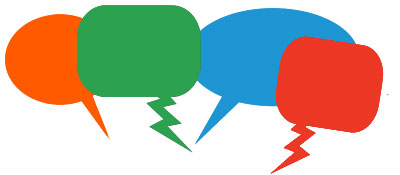 What do you think is going on with your “hamstring tightness”? If the stretching has worked, you can be fairly confident that you had a hamstring problem. But if it’s not working, with this new information, what’s the problem? Is it adhesion in the hamstring? The sciatic nerve at the butt? Or a low back disc?
What do you think is going on with your “hamstring tightness”? If the stretching has worked, you can be fairly confident that you had a hamstring problem. But if it’s not working, with this new information, what’s the problem? Is it adhesion in the hamstring? The sciatic nerve at the butt? Or a low back disc?

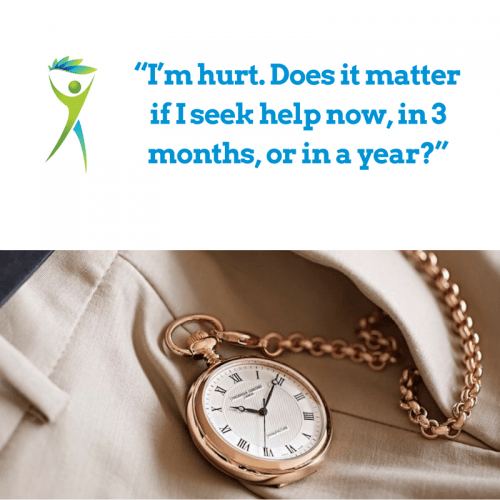
No Comments